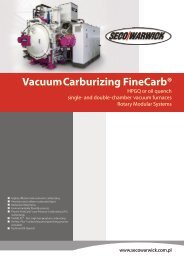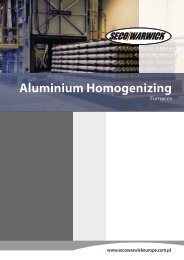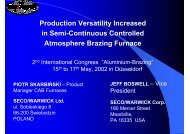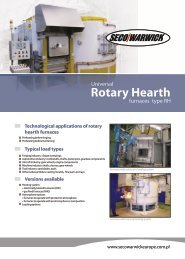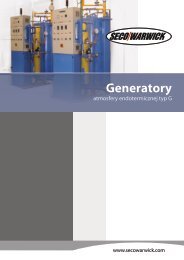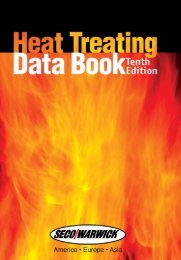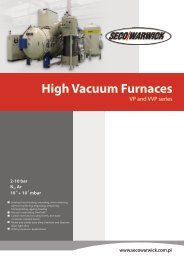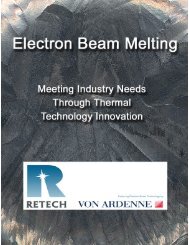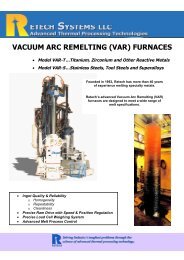Heat treatment of tool steels in vacuum furnaces ... - Seco-Warwick
Heat treatment of tool steels in vacuum furnaces ... - Seco-Warwick
Heat treatment of tool steels in vacuum furnaces ... - Seco-Warwick
Create successful ePaper yourself
Turn your PDF publications into a flip-book with our unique Google optimized e-Paper software.
ARTICLE 2012<strong>Heat</strong> <strong>treatment</strong> <strong>of</strong> <strong>tool</strong> <strong>steels</strong> <strong>in</strong> <strong>vacuum</strong> <strong>furnaces</strong> with gas quenchPart 1. Process requirements and simulationsPhD. Emilia Wołowiec, Pr<strong>of</strong>. Piotr Kula –Technical University <strong>of</strong> Lodz, Lodz, PolandPhD. Maciej Korecki, Eng. Józef Olejnik –SECO/WARWICK S.A., Swiebodz<strong>in</strong>, PolandIn a few wordsTool <strong>steels</strong> constitute the basic material forform<strong>in</strong>g <strong>of</strong> all groups <strong>of</strong> materials and for<strong>tool</strong> manufactur<strong>in</strong>g. A properly designedand controlled cool<strong>in</strong>g process is <strong>of</strong> majorsignificance for the f<strong>in</strong>al effect <strong>of</strong> heat<strong>treatment</strong> and therefore it is underly<strong>in</strong>g forthe durability and service suitability <strong>of</strong> thetreated element.Contemporary heat treat<strong>in</strong>g equipment andtechnologies facilitate massive and effectiveheat <strong>treatment</strong> <strong>of</strong> <strong>tool</strong> <strong>steels</strong>, whileprocess simulators such as G-Quench Pro ®enable design<strong>in</strong>g <strong>of</strong> new <strong>treatment</strong> methodswith simultaneous reduction <strong>of</strong> the timeconsum<strong>in</strong>g test<strong>in</strong>g procedures.IntroductionTool <strong>steels</strong> are a widely used material formak<strong>in</strong>g metal, polymer, ceramic and composite<strong>tool</strong>s which may be formed by mach<strong>in</strong><strong>in</strong>gor plastic form<strong>in</strong>g. S<strong>in</strong>ce the crucialrequirement for a <strong>tool</strong> is its shape stability,the material it is made from is expectedto withhold load<strong>in</strong>g without plasticstra<strong>in</strong> and to be highly resistant to abrasion.Tool <strong>steels</strong> are classified accord<strong>in</strong>g to applications.Dies, punches, stamp<strong>in</strong>g dies,press<strong>in</strong>g rolls and other <strong>tool</strong>s designed forcold process<strong>in</strong>g are made <strong>of</strong> cold work<strong>in</strong>galloy steel such as NCLV, NC10,NC11LV, NZ3 (although <strong>in</strong> practice boththe material and the <strong>tool</strong>s get slightly heat<strong>in</strong>gwhen work<strong>in</strong>g, say as a result <strong>of</strong> frictionor deform<strong>in</strong>g work). The large-sizeextrusion dies, pressure cast<strong>in</strong>g moulds,mandrels, punches and other elements forplastic work<strong>in</strong>g <strong>of</strong> other materials heatedup to higher temperatures (with<strong>in</strong> the range<strong>of</strong> 250-700 o C) are made <strong>of</strong> hot work<strong>in</strong>galloy <strong>steels</strong> (such as WCL, WCLV,WNLV, etc.). This group <strong>of</strong> materials isexpected to show high degree <strong>of</strong> hardness,abrasion resistance, impact strength andgood harden<strong>in</strong>g capacity. The third groupcomprises high speed <strong>steels</strong> (e.g. SW7M,SW18, SK5M) applied chiefly to mach<strong>in</strong>emetals at high speeds (cutters, drills, mill<strong>in</strong>gcutters).Generally speak<strong>in</strong>g, all properly quenched<strong>tool</strong> <strong>steels</strong> are characterized by high hardness,abrasion resistance, small deformabilityand small susceptibility to overheat<strong>in</strong>g.S<strong>in</strong>ce the basic qualities <strong>of</strong> those steelgrades (abrasion resistance, strength, crackresistance, ductility) are greatly dependenton the hardness achieved, it is that parameterthat attracts a lot <strong>of</strong> attention. Properlyrun quench process is <strong>of</strong> major significancefor the target hardness <strong>of</strong> steel elementsand thus determ<strong>in</strong>es their functional suitability.<strong>Heat</strong> <strong>treatment</strong> <strong>of</strong> <strong>tool</strong> <strong>steels</strong><strong>Heat</strong> <strong>treatment</strong> <strong>of</strong> <strong>tool</strong> <strong>steels</strong> consists <strong>of</strong> aharden<strong>in</strong>g process followed immediatelyby a temper<strong>in</strong>g process, which ensures anappropriate structure <strong>of</strong> the material. Itmust be mentioned at this po<strong>in</strong>t that properlyselected chemical composition has amajor <strong>in</strong>fluence on the properties <strong>of</strong> thosematerials. However, this is beyond thescope <strong>of</strong> the present paper. Tool <strong>steels</strong> requireprecision <strong>treatment</strong>, usually <strong>in</strong>dividu-1/7
alized for each grade <strong>of</strong> steel. Detailedguidel<strong>in</strong>es are to be found <strong>in</strong> branch literatureand manufacturers’ material specificationswhile new concepts and trends <strong>in</strong> heat<strong>treatment</strong> are discussed <strong>in</strong> specialist magaz<strong>in</strong>esand at HT branch events [1-4] . Nevertheless,certa<strong>in</strong> similarities can be foundwith<strong>in</strong> application groups <strong>of</strong> those <strong>steels</strong>.Quench<strong>in</strong>g the cold work<strong>in</strong>g <strong>tool</strong> <strong>steels</strong>needs to ensure f<strong>in</strong>e-gra<strong>in</strong>ed steel resistantto abrasion and wear. Such properties areachieved by conduct<strong>in</strong>g the process <strong>in</strong> sucha way that some <strong>of</strong> the carbides rema<strong>in</strong>undissolved <strong>in</strong> the austenite. Therefore, <strong>in</strong>practice those <strong>steels</strong> are quenched down <strong>in</strong>oil from temperatures <strong>of</strong> up to 960 o C.The hot work<strong>in</strong>g <strong>steels</strong> are quenched <strong>in</strong> oilor gas from temperatures <strong>of</strong> up to 1120 o Cand then tempered at temperatures up to600 o C. The austenitiz<strong>in</strong>g temperature is acompromise between the necessity to limitthe growth <strong>of</strong> primary austenite gra<strong>in</strong>s andthe need to dissolve the alloy carbides.Depend<strong>in</strong>g on the <strong>tool</strong> size, quench<strong>in</strong>g processis aimed at obta<strong>in</strong><strong>in</strong>g a martensitestructure (for smaller elements) or martensitewith ba<strong>in</strong>ite (for larger <strong>tool</strong>s). This isfollowed by twice temper<strong>in</strong>g at temperatureor above the po<strong>in</strong>t <strong>of</strong> secondary hardness<strong>in</strong> order to reduce the reta<strong>in</strong>ed austeniteand to <strong>in</strong>crease ductility and resistanceto thermal fatigue. Sometimes supplementaryprocesses are <strong>in</strong>troduced, such as apply<strong>in</strong>gvarious coat<strong>in</strong>gs (CVD, PVD) ornitrid<strong>in</strong>g, which additionally <strong>in</strong>crease thehardness <strong>of</strong> the work<strong>in</strong>g surfaces <strong>of</strong> thetreated <strong>tool</strong>s as well as improve their resistanceto abrasion and corrosion.The high speed <strong>steels</strong> are quenched <strong>in</strong> oilor gas under pressure, down from temperatures<strong>of</strong> up to 1250 o C and then temperedwith<strong>in</strong> 500-600 o C.A properly performed heat <strong>treatment</strong> isdecisive for the mechanical and functionalproperties <strong>of</strong> <strong>tool</strong>s and the economy <strong>of</strong>their application. Allow<strong>in</strong>g any irregularitiesleads to quicker wear, deformation ordefect to functional elements or, <strong>in</strong> extremecases, to their damage (crack<strong>in</strong>g) as earlyas <strong>in</strong> the course <strong>of</strong> heat <strong>treatment</strong>, whichcauses notable f<strong>in</strong>ancial losses. Needless tosay, proper quality and condition <strong>of</strong> the<strong>in</strong>itial material is also significant.Difficulties <strong>in</strong> ensur<strong>in</strong>g quality to largesize<strong>tool</strong>s (moulds and dies) have led to thecreation <strong>of</strong> process<strong>in</strong>g standards. The mostfamiliar are the works published by NAD-CA (North American Die Cast<strong>in</strong>g Association)[5] and those published by the leaders<strong>in</strong> automotive <strong>in</strong>dustry, among others theconcerns <strong>of</strong> Ford [6] and General Motors [7] .These standards apply ma<strong>in</strong>ly to the steelgrade H13 (WCLV) and its modifications:they relate to quality control for <strong>in</strong>itial material,guidel<strong>in</strong>es for conduct<strong>in</strong>g and controll<strong>in</strong>gHT processes and research<strong>in</strong>g theresults.Guidel<strong>in</strong>es for HT <strong>of</strong> hot work<strong>in</strong>g <strong>tool</strong><strong>steels</strong> acc. to NADCAAccord<strong>in</strong>g to NADCA guidel<strong>in</strong>es, HT processshould be performed <strong>in</strong> a <strong>vacuum</strong> furnacewith high pressure gas quench whilethe surface and core temperatures <strong>of</strong> a processedworkpiece is monitored and controlled(precise locations for workloadthermocouples are predeterm<strong>in</strong>ed).<strong>Heat</strong><strong>in</strong>g up to austenitiz<strong>in</strong>g temperature iseffected gradually <strong>in</strong> order not to allow anysignificant temperature difference. Thefirst heat<strong>in</strong>g stop is at the temperature <strong>of</strong>approx. 650 o C and cont<strong>in</strong>ues until the temperaturedifference between the core andsurface is below 110 o C (practically muchbelow that). The next stop is preset at850 o C and cont<strong>in</strong>ues until the temperaturesequalize, with the difference not exceed<strong>in</strong>g14 o C. F<strong>in</strong>ally, the austenitiz<strong>in</strong>g temperature<strong>of</strong> 1030 o C is reached at which soak<strong>in</strong>gfollows for 30 m<strong>in</strong>utes until the temperaturesequalize (with permissible temperaturedifference below 14 o C) or for maximum90 m<strong>in</strong>utes from reach<strong>in</strong>g 1030 o C atthe surface. These guidel<strong>in</strong>es limit thermaldeformations and excessive growth <strong>of</strong> austenitegra<strong>in</strong>.2/7
Dies are hardened by be<strong>in</strong>g quenched atmaximum speed down to the temperature<strong>of</strong> 150 o C <strong>in</strong> the core. The average surfacequench ratio down to 540 o C should be atleast 28 o C/m<strong>in</strong>. In the event <strong>of</strong> large-sizedies (<strong>of</strong> cross-sections above 300 mm),isothermal cool<strong>in</strong>g is applied at surfacetemperature <strong>of</strong> 400-450 o C when the coretemperature diverges by more than 100 o C.Isothermal stop is f<strong>in</strong>ished when one <strong>of</strong> thefollow<strong>in</strong>g conditions occurs:⎯ core temperature differs from surfacetemperature by more than100 o C⎯ surface temperature drops below400 o C⎯ 30 m<strong>in</strong>utes have elapsed from theonset <strong>of</strong> the isothermal stop.Quench<strong>in</strong>g is cont<strong>in</strong>ued until 50 o C is obta<strong>in</strong>ed<strong>in</strong> the core, follow<strong>in</strong>g which temper<strong>in</strong>gstarts immediately. Workloads should notbe cooled down below the temperature <strong>of</strong>33 o C. The required cool<strong>in</strong>g rate is essentialdue to the risk <strong>of</strong> emission <strong>of</strong> carbides atgra<strong>in</strong> limits, which results <strong>in</strong> an impairedimpact strength. Isothermal cool<strong>in</strong>g restrictsthe temperature difference <strong>of</strong> thesurface and the core and thus decreasesstresses and deformations, protects thepiece aga<strong>in</strong>st crack<strong>in</strong>g and prevents creation<strong>of</strong> a pearlitic structure.The first temper<strong>in</strong>g is performed at thetemperature <strong>of</strong> m<strong>in</strong>imum 565 o C by hold<strong>in</strong>gfor the time depend<strong>in</strong>g on the cross-section<strong>of</strong> the <strong>tool</strong> (1h / 25 mm), but not shorterthan for 2 hours. This is followed by cool<strong>in</strong>gdown to ambient temperature and secondtemper<strong>in</strong>g at the temperature not lowerthan 550 o C. Third temper<strong>in</strong>g is not necessaryand is applied only for f<strong>in</strong>al correction<strong>of</strong> hardness. The temper<strong>in</strong>g processes reducethe <strong>in</strong>ternal stresses, ensure dimensionalstability and proper structure as wellas the required hardness, usually with<strong>in</strong> therange <strong>of</strong> 42-52 HRC.Fig. 1. Horizontal <strong>vacuum</strong> furnace model15.0 VPT (SECO/WARWICK)Vacuum furnace with gas quenchThe requirements set by NADCA concern<strong>in</strong>gheat <strong>treatment</strong> <strong>of</strong> moulds and dies aremade feasible <strong>in</strong> a s<strong>in</strong>gle chamber <strong>vacuum</strong>furnace equipped with <strong>in</strong>ert high pressuregas quench system (type HPGQ) [8-13] . Nationalcompany SECO/WARWICK hasdeveloped a type-series <strong>of</strong> 15.0 VPT <strong>furnaces</strong>dedicated specially to heat <strong>treatment</strong><strong>of</strong> <strong>tool</strong>s. These <strong>furnaces</strong> meet the toughestrequirements set by the <strong>tool</strong> branch and aredelivered to customers all over the world(European countries, the USA, Mexico,Brazil, Ch<strong>in</strong>a, India, and even Australia).Furnaces <strong>of</strong> various volume <strong>of</strong> work<strong>in</strong>garea are available start<strong>in</strong>g from400/400/600 through 600/600/900,900/800/1200, 1200/1200/1800 mm andlarger, featur<strong>in</strong>g horizontal or vertical load<strong>in</strong>gsystem (Fig. 1).3/7
Fig.2. Austenitiz<strong>in</strong>g and quench<strong>in</strong>g withisothermal stop and with monitor<strong>in</strong>g <strong>of</strong>furnace temperature and temperature <strong>of</strong>die surface and coreThe <strong>furnaces</strong> feature a compact design andas they do not emit pollutants or other noxiousagents, they may be <strong>in</strong>stalled and operated<strong>in</strong> clean work<strong>in</strong>g spaces. They areequipped with a graphite heat<strong>in</strong>g chamberwhich permits heat<strong>in</strong>g the workload up tothe temperature <strong>of</strong> 1300 o C with uniformity<strong>of</strong> +/- 5 o C or better. This is achieved due tothe circumferentially placed heat<strong>in</strong>g elementsprovid<strong>in</strong>g radiation heat<strong>in</strong>g <strong>in</strong> <strong>vacuum</strong>and <strong>in</strong>ert gas (convection, ConFlapsystem), which ensures effective and uniformheat<strong>in</strong>g also at low temperatures. Thefurnace quenches <strong>in</strong> <strong>in</strong>ert gas at high pressure(15 atm) forced <strong>in</strong> a close circuit by ablower. Cool<strong>in</strong>g gas is forced through thecircumferentially placed nozzles directlyonto the workload wherefrom the heat iscollected and passed to the <strong>in</strong>ternal heatexchanger. The cool<strong>in</strong>g system providesfor isothermal quench<strong>in</strong>g by controll<strong>in</strong>gcool<strong>in</strong>g <strong>in</strong>tensity with the blower’s capacityand gas pressure (Fig. 2). Effectiveness<strong>of</strong> gas cool<strong>in</strong>g <strong>in</strong> 15.0 VPT <strong>furnaces</strong> wasvalidated through tests on a reference steelblock 400/400/400 mm (Fig.3.) whenspeeds from 40 to 80 o C/m<strong>in</strong> were achieved(cf. required by NADCA – 28 o C/m<strong>in</strong> andGM – 39 o C/m<strong>in</strong>).Fig.3. Test <strong>of</strong> quench speed acc. to NAD-CA on a reference steel block <strong>of</strong>400/400/400 mmA <strong>vacuum</strong> furnace enables carry<strong>in</strong>g out theentire <strong>treatment</strong> <strong>in</strong> a s<strong>in</strong>gle unit, withoutworkload transfer, and <strong>in</strong> a s<strong>in</strong>gle work<strong>in</strong>gcycle which conta<strong>in</strong>s the follow<strong>in</strong>g subsequentstages: heat<strong>in</strong>g for austenitiz<strong>in</strong>g,isothermal quench<strong>in</strong>g, repeated temper<strong>in</strong>gand also nitrid<strong>in</strong>g. The process may bemonitored through workload thermocoupleslocated <strong>in</strong> an optional place <strong>of</strong> the die.Ideally clean surface <strong>of</strong> the workpieces isthe effect <strong>of</strong> the <strong>treatment</strong> run <strong>in</strong> <strong>vacuum</strong>and <strong>in</strong> <strong>in</strong>ert gases (Fig. 4).Fig.4. A die <strong>in</strong> the <strong>vacuum</strong> furnace chamberfollow<strong>in</strong>g complex heat <strong>treatment</strong>Tool steel quench simulatorDeterm<strong>in</strong>ation <strong>of</strong> the <strong>in</strong>terdependenciesbetween the structure, technological processand functional properties is <strong>of</strong> key importancefor correct and optimal <strong>tool</strong>4/7
manufactur<strong>in</strong>g. It is so because selection <strong>of</strong>an appropriate material comb<strong>in</strong>ed with anappropriate technology ensures the bestproduct durability at the lowest cost.Accelerated advancement <strong>of</strong> civilizationhas <strong>in</strong>itiated <strong>in</strong>creased consumer expectationstowards a number <strong>of</strong> <strong>in</strong>dustries, concern<strong>in</strong>gproduct quality and durability withsimultaneously expected reduction <strong>in</strong> hazardousemissions and m<strong>in</strong>imized energyconsumption. This <strong>in</strong> turn has broughtabout a number <strong>of</strong> changes <strong>in</strong> the approachto manufactur<strong>in</strong>g.Nowadays, the traditional method <strong>of</strong> reach<strong>in</strong>goptimum product properties and technologicalparameters by trial and error iscommonly replaced with simulation andprediction methods which allow the productand its technology to be computerdesigned.In numerous cases computer hastaken over the control <strong>of</strong> manufactur<strong>in</strong>gwhile the grow<strong>in</strong>g popularity <strong>of</strong> this solutionis visible <strong>in</strong> the expand<strong>in</strong>g market <strong>of</strong>digital equipment. <strong>Heat</strong> <strong>treatment</strong> has alsowitnessed an <strong>in</strong>terest <strong>in</strong> applications forprocess model<strong>in</strong>g and simulation. Thisconcerns the technological process itself aswell as the f<strong>in</strong>al properties <strong>of</strong> heat treatedelements [14-19] .The general use simulation s<strong>of</strong>tware consideronly the standard parameters <strong>of</strong> agiven phenomenon, which leads to the f<strong>in</strong>alresults be<strong>in</strong>g burdened with an error. Amethod to <strong>in</strong>crease the precision <strong>of</strong> calculationsis to take <strong>in</strong>to account the parameters<strong>of</strong> the environment <strong>in</strong> which a processis effected, <strong>in</strong> this <strong>in</strong>stance the <strong>in</strong>dividualcharacteristics <strong>of</strong> a quench<strong>in</strong>g furnace as itis the case with the G-Quench Pro simulator.It may seem that the <strong>in</strong>dividual properties<strong>of</strong> a mach<strong>in</strong>e would tie the applicationto a given piece <strong>of</strong> equipment and thusrender it useless for others. However, appropriateparametrization <strong>of</strong> the sett<strong>in</strong>gspermits to reta<strong>in</strong> the versatility <strong>of</strong> the s<strong>of</strong>tware,thereby it may be used on variousunits <strong>of</strong> equipment. Despite the above, thissolution is rarely found <strong>in</strong> <strong>in</strong>dustrial practice.Fig. 5. Overall view <strong>of</strong> a s<strong>of</strong>tware for simulationand control <strong>of</strong> <strong>tool</strong> steel quench<strong>in</strong>gprocessThe G-Quench Pro s<strong>of</strong>tware (Fig.5) is appliedto simulate and control <strong>tool</strong> steelquench<strong>in</strong>g <strong>in</strong> gas, thus reduc<strong>in</strong>g the needfor test runs. The mathematical pr<strong>in</strong>ciples<strong>of</strong> the quench process and the dependence<strong>of</strong> material hardness from quench timehave been developed on the basis <strong>of</strong> theresearch carried out at the University <strong>of</strong>Technology <strong>in</strong> Łódź, Poland andSECO/WARWICK company, with dueconsideration <strong>of</strong> available literature.A direct result <strong>of</strong> such simulation is determ<strong>in</strong>ation<strong>of</strong> a cool<strong>in</strong>g curve for a givenmaterial under given conditions. The cool<strong>in</strong>gcurve is determ<strong>in</strong>ed bas<strong>in</strong>g on the parameters<strong>of</strong> the material, the process andthe workpiece such as quench temperature,pressure and type <strong>of</strong> cool<strong>in</strong>g gas, dimensionsand curvature <strong>of</strong> the workpiece anddensity <strong>of</strong> workpieces <strong>in</strong> the quench chamber.Comb<strong>in</strong>ed with an <strong>in</strong>dividual phasediagram for the material, the curve provides<strong>in</strong>formation on the phases throughwhich the steel goes dur<strong>in</strong>g <strong>treatment</strong>. Theultimate effect <strong>of</strong> simulation is determ<strong>in</strong>ation<strong>of</strong> quench speed and predicted f<strong>in</strong>alhardness <strong>of</strong> the material.As it was mentioned earlier, <strong>in</strong>dividualparameters <strong>of</strong> a quench unit largely determ<strong>in</strong>ethe actual process and, as a result, thesame parameters preset on two differentunits may render differently hardened5/7
steel. Therefore, at the <strong>in</strong>stallation stagethe s<strong>of</strong>tware is configured for a particularphysical piece <strong>of</strong> equipment assignedthereto. In this way the <strong>in</strong>dividual characteristics<strong>of</strong> a furnace is also taken <strong>in</strong>to considerationwhen def<strong>in</strong><strong>in</strong>g f<strong>in</strong>al properties <strong>of</strong>the product.Quench process controlMonitor<strong>in</strong>g <strong>of</strong> quench process is an essentialelement <strong>of</strong> the manufactur<strong>in</strong>g cycle.Although process control is a cyclic procedureand occurs at every stage <strong>of</strong> production(design, process, test<strong>in</strong>g f<strong>in</strong>al product),here it is exceptionally important as this isthe last stage which <strong>of</strong>fers a possibility <strong>of</strong><strong>in</strong>tervention and change to quench parameters.Test<strong>in</strong>g the f<strong>in</strong>al product merely givesa possibility to acknowledge a faulty<strong>treatment</strong> afterwards. On the other hand,monitor<strong>in</strong>g <strong>of</strong> the quench process <strong>in</strong> realtime provides for immediate <strong>in</strong>tervention<strong>of</strong> the operator should any irregularities <strong>in</strong>the progress <strong>of</strong> the <strong>treatment</strong> be found.Fig. 6. Monitor<strong>in</strong>g <strong>of</strong> proper progress <strong>of</strong>quench process <strong>in</strong> real time with the G-Quench Pro s<strong>of</strong>twareIn the monitor mode the s<strong>of</strong>tware requiresa remote or direct connection to the quenchunit. Co-operat<strong>in</strong>g with the furnace computerit downloads feedback on the currenttemperature <strong>in</strong> the chamber or <strong>in</strong> thequenched workpiece and then plots thereadouts onto the phase diagram. Real timeprocess curve is plotted upon the cool<strong>in</strong>gcurve determ<strong>in</strong>ed by the simulator (Fig. 6).This way the quench process undergoescurrent verification.SummaryTool <strong>steels</strong> are basic material for form<strong>in</strong>gall types <strong>of</strong> materials and for <strong>tool</strong> manufactur<strong>in</strong>g.A properly designed and controlledcool<strong>in</strong>g process is <strong>of</strong> major significance forthe f<strong>in</strong>al effect <strong>of</strong> heat <strong>treatment</strong> and thereforeit is underly<strong>in</strong>g for the durability andservice suitability <strong>of</strong> the treated element.Contemporary heat treat<strong>in</strong>g equipment andtechnologies facilitate massive and effectiveheat <strong>treatment</strong> <strong>of</strong> <strong>tool</strong> <strong>steels</strong>, whilequench process simulators facilitate highlyaccurate prediction <strong>of</strong> process results withsimultaneous reduction <strong>of</strong> the time consum<strong>in</strong>gtest<strong>in</strong>g procedures.Bibliography[1] M. Korecki, J. Olejnik, R. Gorockiewicz: Rozwójpieców HPQ na przykładzie aplikacji nawęglaniapróżniowego F<strong>in</strong>eCarb, obróbki cieplnej staliHSLA oraz nowoczesnej obróbki cieplnej narzędzi.XI Sem<strong>in</strong>arium Nowoczesne trendy w obróbcecieplnej. Bukowy Dworek 2007.[2] M. Korecki, J Olejnik, Z. Szczerba, M. Bazel:Jednokomorowy piec próżniowy HPGQ z efektywnościąhartowania porównywalną z olejem. IVKonferencja Naukowa Nowoczesne Technologie wInżynierii Powierzchni. Spała 2010.[3] E. Wołowiec, L. Małdziński, M. Korecki: Komputerowenarzędzia wspierające obróbkę cieplną icieplno-chemiczną. Piece Przemysłowe & KotłyXI/XII 2011, 8-14.[4] E. Wołowiec, P. Kula, M. Korecki, J. Olejnik:Simulation and Control <strong>of</strong> Tool Steel Quench<strong>in</strong>gProcess. 25th European Conference on Model<strong>in</strong>gand Simulation. Kraków 2011, 357-361.[5] Nord American Die Cast<strong>in</strong>g Association: SpecialQuality die steel & heat <strong>treatment</strong> acceptancecriteria for die cast<strong>in</strong>g dies. Vacuum heat <strong>treatment</strong>,2008.[6] FORD Motor Company, Advanced Manufactur<strong>in</strong>gDevelopment - DC2010: Die <strong>in</strong>sert material andheat <strong>treatment</strong> performance requirements, 2005.[7] GM Powertra<strong>in</strong> Group DC-9999: Die <strong>in</strong>sertmaterial and heat treat<strong>in</strong>g specification, 2005.[8] J. Olejnik: Vacuum <strong>furnaces</strong> with high pressurecharge cool<strong>in</strong>g. Metallurgy 3/2002.[9] M. Korecki: Technical and Technological Properties<strong>of</strong> Gas Cool<strong>in</strong>g <strong>in</strong> High Pressure Chamber.6/7
IX Sem<strong>in</strong>arium Nowoczesne trendy w obróbcecieplnej. Bukowy Dworek 2005.[10] J. Kowalewski, M. Korecki, J. Olejnik: NextGeneration HPQ Vacuum Furnace. <strong>Heat</strong> Treat<strong>in</strong>gProgress 8 2008.[11] M. Korecki, J. Olejnik, Z. Szczerba, M. Bazel:S<strong>in</strong>gle-Chamber 25 bar HPGQ Vacuum Furnacewith Quench<strong>in</strong>g Efficiency Comparable to Oil.Industrial <strong>Heat</strong><strong>in</strong>g 9 2009, 73-77.[12] M. Korecki, J. Olejnik, Z. Szczerba, M. Bazel,R. Atraszkiewicz: Piec próżniowy <strong>Seco</strong>/<strong>Warwick</strong>typ 25VPT z hartowaniem w azocie i helu podciśnieniem 25 bar i jego nowe możliwości technologiczne.XIII Sem<strong>in</strong>arium Nowoczesne trendy wobróbce cieplnej. Bukowy Dworek 2010.[13] M. Korecki, P. Kula, J. Olejnik: New Capabilities<strong>in</strong> HPGQ Vacuum Furnaces. Industrial <strong>Heat</strong><strong>in</strong>g3 2011.[14] L.A. Dobrzański, J. Madejski, W. Mal<strong>in</strong>a, W.Sitek: The prototype <strong>of</strong> an expert system for theselection <strong>of</strong> high-speed <strong>steels</strong> for cutt<strong>in</strong>g <strong>tool</strong>s.Journal <strong>of</strong> Materials Process<strong>in</strong>g Technology 56/1-41996, 873-881.[15] L.A. Dobrzański, J. Trzaska: Application <strong>of</strong>neural network for the prediction <strong>of</strong> cont<strong>in</strong>ous cool<strong>in</strong>gtransformation diagrams. Computational MaterialsScience 30/3-4 2004, 251-259.[16] P. Kula, R. Atraszkiewicz, E. Wołowiec: Moderngas quench<strong>in</strong>g chambers supported by SimVacPlus hardness application. AMT <strong>Heat</strong> Treatment,Detroit 2007.[17] P. Kula, M. Korecki, R. Pietrasik et al.: F<strong>in</strong>e-Carb - the Flexible System for Low-pressure Carburiz<strong>in</strong>g.New Options and Performance. The JapanSociety for <strong>Heat</strong> Treatment 49 2009, 133-136.[18] W. Sitek: Methodology <strong>of</strong> high-speed <strong>steels</strong>design us<strong>in</strong>g the artificial <strong>in</strong>telligence <strong>tool</strong>s. Journal<strong>of</strong> Achievements <strong>in</strong> Materials and Manufactur<strong>in</strong>gEng<strong>in</strong>eer<strong>in</strong>g 39/2 2010, 115-160.[19] E. Wołowiec, L. Małdziński, M. Korecki:Nowe <strong>in</strong>teligentne programy wspierające produkty<strong>Seco</strong>/<strong>Warwick</strong>. XIV Sem<strong>in</strong>arium Nowoczesnetrendy w obróbce cieplnej. Bukowy Dworek 2011,71-80.7/7





